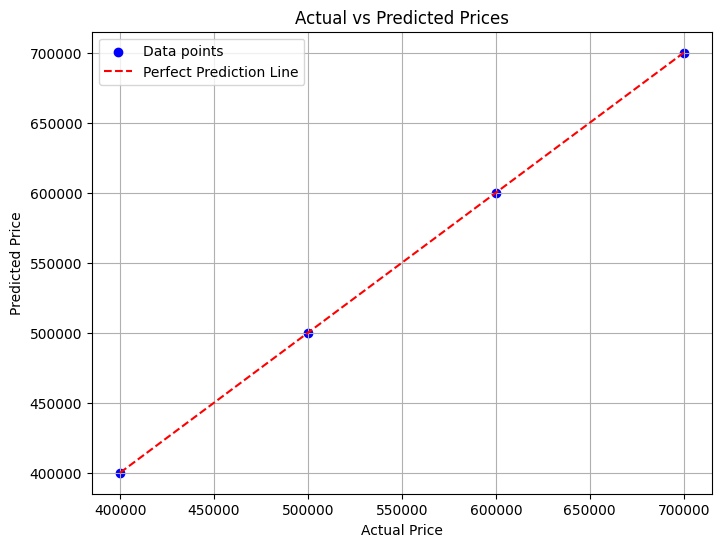Multiple Linear Regression
Multiple Linear Regression is an extension of linear regression where we predict the value of a dependent variable (Y) based on multiple independent variables (X₁, X₂, X₃, ....). It models the relationship between the dependent variable and multiple predictors using the equation:
Y = b₀ + b��₁X₁ + b₂X₂ + ... + bₙXₙ + ϵ
Where:
- Y: Dependent variable
- X₁, X₂, ..., Xₙ: Independent variables
- b₀: Intercept (value of Y when all Xᵢ = 0)
- b₁, b₂, ..., bₙ: Coefficients representing the effect of each Xᵢ on Y
- ϵ: Error term (difference between actual and predicted Y)
Example: Predicting House Prices
Suppose we want to predict house prices based on three features: size of the house (X₁), number of bedrooms (X₂), and distance to the city center (X₃).
Data
| House Size (sq ft) ((X₁)) | Bedrooms ((X₂)) | Distance to City (miles) ((X₃)) | Price ((Y)) |
|---|---|---|---|
| 1500 | 3 | 5 | 400,000 |
| 2000 | 4 | 3 | 500,000 |
| 2500 | 4 | 2 | 600,000 |
| 3000 | 5 | 1 | 700,000 |
Regression Equation
Using multiple linear regression, we fit the following equation:
Y = b₀ + b₁·X₁ + b₂·X₂ + b₃·X₃
Assuming the computed coefficients are:
- b₀ = 50,000: Intercept (the value of Y when all Xᵢ = 0)
- b₁ = 100: Coefficient for X₁ (per square foot)
- b₂ = 10,000: Coefficient for X₂ (per bedroom)
- b₃ = -20,000: Coefficient for X₃ (per mile from the city)
The equation becomes:
Y = 50,000 + 100·X₁ + 10,000·X₂ - 20,000·X₃
Prediction
For a house of size 2200 sq ft, 3 bedrooms, and 4 miles from the city:
Y = 50,000 + 100(2200) + 10,000(3) - 20,000(4)
Y = 50,000 + 220,000 + 30,000 - 80,000 = 220,000
The predicted price is $220,000.
Advantages of Multiple Linear Regression
- Captures Relationships: It identifies the influence of multiple factors on a dependent variable.
- Predictive Power: It enhances prediction accuracy by incorporating multiple variables.
- Quantifies Impact: Provides insight into the effect of each independent variable.
Limitations
- Multicollinearity: When predictors are highly correlated, it can distort coefficient estimates.
- Overfitting: Too many predictors relative to the data size can reduce model generalizability.
- Linearity Assumption: Assumes a linear relationship between predictors and the outcome.
Multiple linear regression is a cornerstone of statistical modeling and machine learning, widely used in fields like economics, healthcare, and marketing for predictive analysis.
code to predict house prices
# Importing necessary libraries
import numpy as np
import pandas as pd
import matplotlib.pyplot as plt
from sklearn.linear_model import LinearRegression
# Creating the dataset
data = {
"House Size (sq ft)": [1500, 2000, 2500, 3000],
"Bedrooms": [3, 4, 4, 5],
"Distance to City (miles)": [5, 3, 2, 1],
"Price": [400000, 500000, 600000, 700000]
}
# Convert to DataFrame
df = pd.DataFrame(data)
# Features (X) and Target (Y)
X = df[["House Size (sq ft)", "Bedrooms", "Distance to City (miles)"]]
Y = df["Price"]
# Linear regression model
model = LinearRegression()
model.fit(X, Y)
# Coefficients and Intercept
b0 = model.intercept_
coefficients = model.coef_
# Predict prices based on the model
df["Predicted Price"] = model.predict(X)
# Plot actual vs predicted prices
plt.figure(figsize=(8, 6))
plt.scatter(df["Price"], df["Predicted Price"], color='blue', label='Data points')
plt.plot(df["Price"], df["Price"], color='red', linestyle='--', label='Perfect Prediction Line')
plt.title("Actual vs Predicted Prices")
plt.xlabel("Actual Price")
plt.ylabel("Predicted Price")
plt.legend()
plt.grid(True)
plt.show()
# Display coefficients and intercept
b0, coefficients
